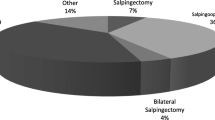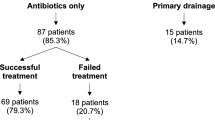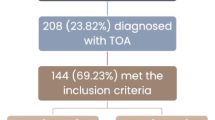Abstract
Purpose
Tubo-ovarian abscess (TOA) is a serious and potentially life-threatening complication of pelvic inflammatory disease (PID). TOA formation may be an uncommon, but serious complication associated with the use of an intrauterine device (IUD). While the majority of TOA respond to antibiotic therapy, in approximately 25% of cases surgery or drainage is indicated. In the present study, we compared the failure rate of conservative management in patients with and without IUD, who were admitted with a diagnosis of TOA.
Methods
In this retrospective case–control study, 78 women were diagnosed with TOA. All patients were treated initially by broad-spectrum intravenous antibiotics. The failure of conservative management after 72 h was followed by surgical intervention.
Results
The patients were divided into two groups: 24 patients were IUD-carriers, and 54 did not use IUD. There was no significant difference in surgical intervention rate between IUD group (50%) and no-IUD group (43%), p = 0.32. The WBC count was significantly higher in IUD-carriers diagnosed with TOA than in patients without IUD (16.5 ± 6.6 vs. 13.1 ± 4.6, p = 0.001). The patients with IUD had significantly larger abscesses as revealed by ultrasound than patients without IUD (61.6 ± 21.4 vs. 49.6 ± 20.6 mm, p = 0.02).
Conclusion
The surgical intervention rate in TOA patients with and without IUD was similar.
Similar content being viewed by others
References
Granberg S, Gjelland K, Ekerhovd E (2009) The management of pelvic abscess. Best Res Clin Obstet Gynaecol 23(5):667
Sorbiye IK, Jerve F, Staff AC (2005) Reduction in hospitalized women with pelvic inflammatory disease in Oslo over the past decade. Acta Obstet Gynecol Scand 84(3):290
Pedowitz P, Bloomfield RD (1964) Ruptured adnexal abscess with generalized peritonitis. Am J Obstet Gynecol 88:721
Rosen M, Breitkopf D, Waud K (2009) Tubo-ovarian abscess management options for women who desire fertility. Obstet Gynecol Surv 64(10):681
Wiesenfeld HC, Sweet RL (1993) Progress in the management of tubo-ovarian abscesses. Clin Obstet Gynecol 36(2):433
Landers DV, Sweet RL (1983) Tubo-ovarian abscess: a contemporary approach to management. Rev Infect Dis 5:876–884
Chappell C, Wiesenfeld HC (2012) Pathogenesis, diagnosis, and management of severe pelvic inflammatory disease and tubo-ovarian abscess. Clin Obstet Gynecol 55(4):893–903
Scott WC (1978) Pelvic abscess in association with intrauterine contraceptive device. Am J Obstet Gynecol 131(2):149
Toglia MR, Schaffer JI (1996) Tubo-ovarian abscess formation in users of intrauterine device remote from insertion: a report of three cases. Infect Dis Obstet Gynecol 4:85–88
Levenson RB, Pearson KM, Saokar A, Lee SI, Mueller PR, Hahn PF (2011) Image-guided drainage of tuboovarian abscesses of gastrointestinal or genitourinary origin: a retrospective analysis. J Vasc Interv Radiol 22:678–686
Granberg S, Gjelland K, Ekerhovd E (2009) Best practice and research. Clin Obstet Gynecol 23(5):667–678
Kuo CF, Tsai SY, Liu TC, Lin CC, Liu CP, Lee CM (2012) Clinical characteristics and treatment outcomes of patients with tubo-ovarian abscess at a tertiary care hospital in Northern Taiwan. J Microb Immun Infect 45:58–64
Greenstein Y, Shah AJ, Vragovic O, Cabral H, Soto-Wright V, Borgatta L, Kuohung W (2013) Tuboovarian abscess. Factors associated with operative intervention after failed antibiotic therapy. J Reprod Med 58(3–4):101–106
Halperin R, Levinson O, Yaron M, Bukovsky I, Schneider D (2003) Tubo-ovarian abscess in older women: is the women’s age a risk factor for failed response to conservative treatment? Gynecol Obstet Invest 55(4):211–215
Author information
Authors and Affiliations
Contributions
VK: manuscript writing-editing, data analyzing. AN: manuscript editing, data analyzing. OY: data collection. MV: data collection. EA: supervisor. OG: supervisor, project administration, manuscript editing, data analyzing.
Corresponding author
Ethics declarations
Conflict of interest
We have no potential conflict of interest to declare.
Ethical approval
This article does not contain any studies with human participants or animals performed by any of the authors.
Informed consent
The study was designed as a retrospective study. All data were collected anonymously. The Ethical board waived informed consent.
Rights and permissions
About this article
Cite this article
Kapustian, V., Namazov, A., Yaakov, O. et al. Is intrauterine device a risk factor for failure of conservative management in patients with tubo-ovarian abscess? An observational retrospective study. Arch Gynecol Obstet 297, 1201–1204 (2018). https://doi.org/10.1007/s00404-018-4690-z
Received:
Accepted:
Published:
Issue Date:
DOI: https://doi.org/10.1007/s00404-018-4690-z




